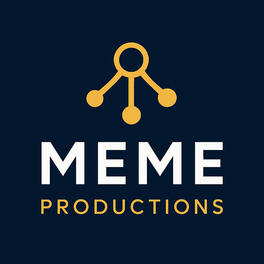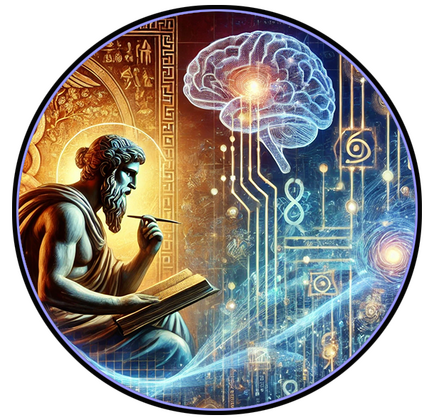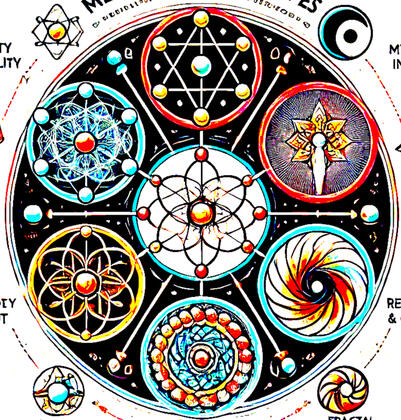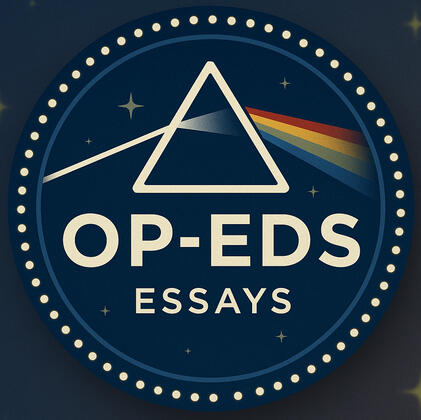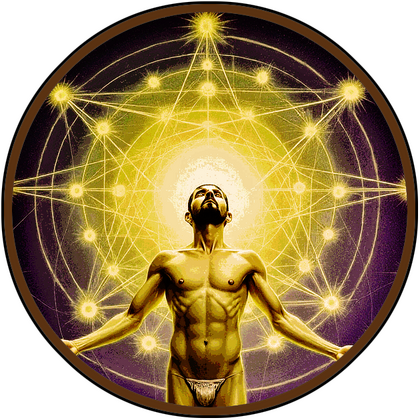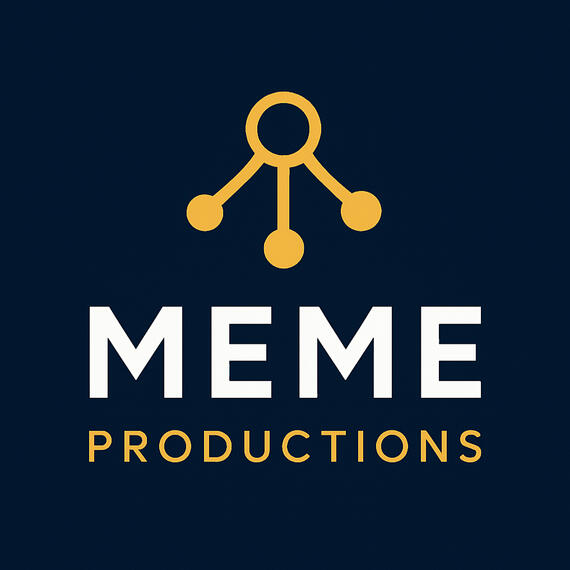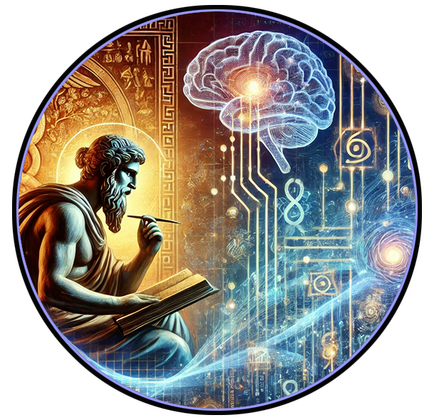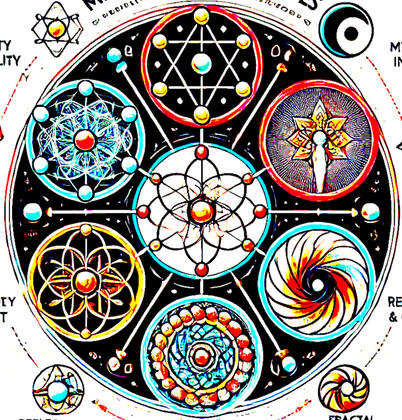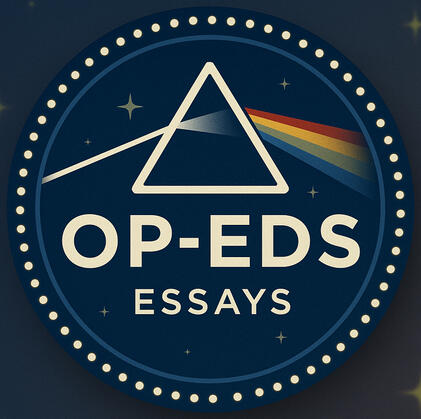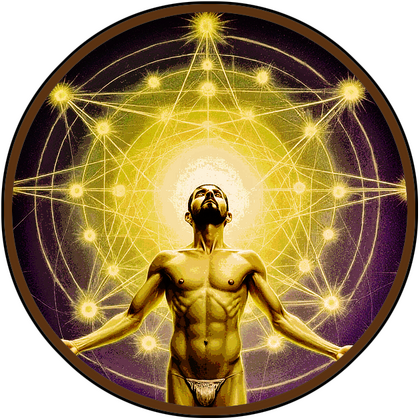
Scaffolding the Mind

The structure of thought reveals itself in the form it takes.
This essay is about Language, Spectacle, and the Hijacking of Perception.

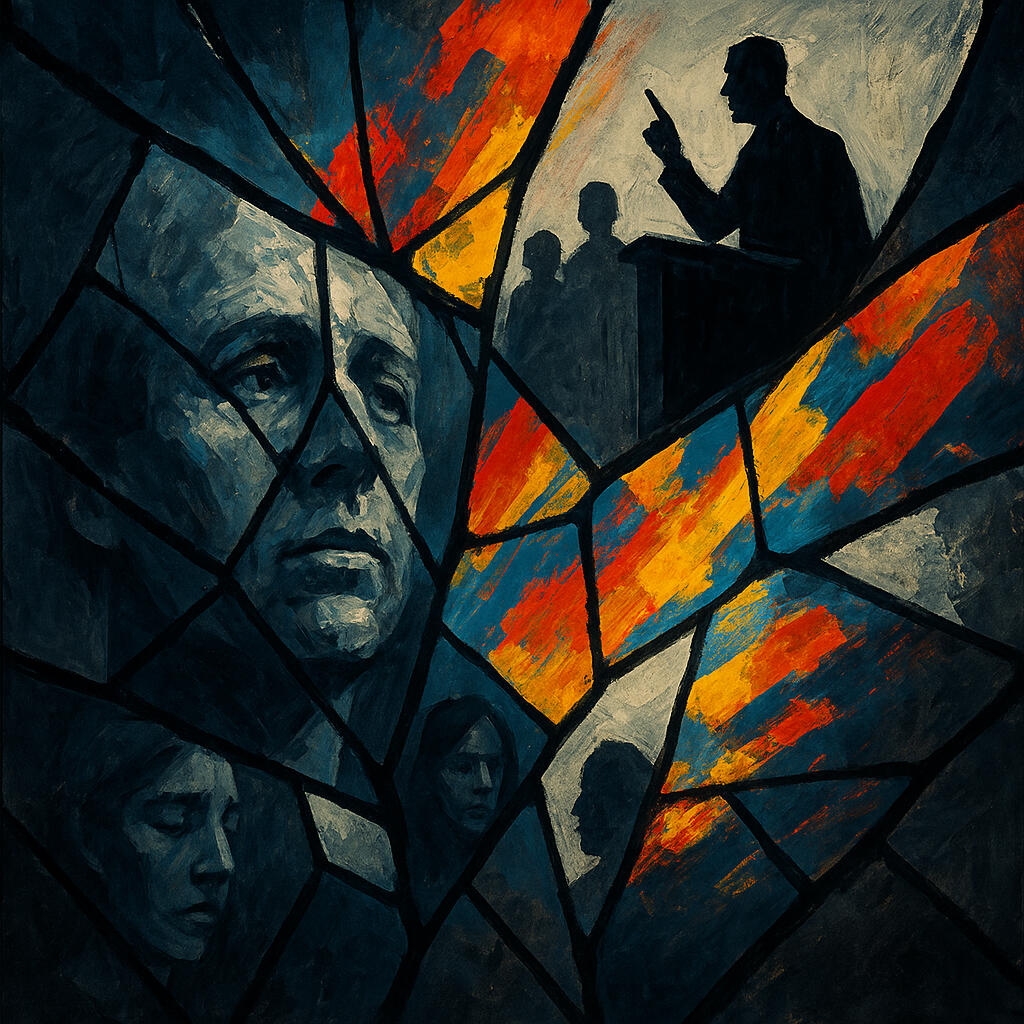

"The pendulum of the mind oscillates between sense and nonsense, not between right and wrong.”
— C.G. Jung







Prologue: Reflections Before the Mirror

Something is breaking beneath the surface of modern life — not only in politics or culture, but in the very structure of how we think. What once held coherence is now fragmented. Where there was once nuance, now there is noise. Where we once reached for shared meaning, we now recoil into tribes of certainty. The language we use, the stories we tell, the causes we rally behind — all seem increasingly hollow, yet emotionally charged. Symbols that once connected us have become masks, and spectacle has replaced dialogue.And yet… something within still remembers. Still resists. Still reaches.This essay is not a call to arms for any political ideology. It is not a defence of any party or persuasion. It is a call back to the ground beneath thought itself — a call to restore the lost thread of reflection, to recover the space where understanding lives. The pages that follow explore how language and imagery — memes, metaphors, narrative rituals — shape the psychic scaffolding of modern life. We follow them not as curiosities, but as clues. Clues to how thought is hijacked, how agency is lost, and how it might still be reclaimed.This is an essay about how we think — and how that very process is being rewritten beneath our feet.

Introduction: Through the Mirror of the Meme

We are living in an age where meaning is no longer shared, but performed. Where the symbols meant to connect us — language, flag, story, cause — are no longer vessels of understanding, but tools of allegiance. Our world has become a spectacle, and we, the audience, are trapped in its looping theatre.Yet this isn’t a story about decline. It’s a return — a descent into the underworld of cognition itself, where language and perception shape the worlds we inhabit. In this essay, we explore the structure behind the spectacle — how memes function not as cultural jokes or internet artifacts, but as symbolic carriers that shape attention, hijack thought, and fracture the shared mirror of human reality.Following on from Fractured Mirrors and The Spectacle and the Root of Agency, we now look more deeply at how memes, metaphors, and models of thought interact with our neurological and symbolic infrastructure — not just to influence what we believe, but to restructure the very way we think.This is the architecture of cognition under siege.These linguistic shortcuts become cognitive pathways — automatic structures that reduce complexity and increase communicative speed.Memes operate in much the same way. They are compressed packets of metaphor and emotion, capable of transmitting complex cultural narratives in a single symbolic flash. They do not merely inform — they infect. They become carriers of worldview, transmitting ideology in disguise.¹In this way, language is both our greatest power and our deepest vulnerability. It can be hijacked — not just from the outside, but from within — through memes that align with emotional resonance, metaphors that bypass critical analysis, and symbolic rituals that override reflection.The meme, then, is not merely a joke or an image — it is a mirror. It reflects the architecture of our thought — and sometimes, distorts it.


References – Introduction:Through the Mirror of the Meme
¹ Susan Blackmore, The Meme Machine, Oxford University Press, 1999.









Language and the Architecture of Thought


Before a belief is formed or a narrative embraced, something deeper is already at work: the architecture of cognition itself. Human beings are not passive recipients of information; we are pattern-making, symbol-interpreting creatures. We do not merely see the world — we model it. And we do so through the medium of language.Language is not simply a communication tool — it is the operating system of consciousness. It gives shape to what we notice, how we frame experience, and what we believe is possible. Memes, metaphors, idioms, and symbolic patterns serve as the structural ligaments of that system. They guide perception, stitch context to content, and allow us to map one domain of meaning onto another.Ludwig Wittgenstein famously wrote, “The limits of my language mean the limits of my world.”¹ What he meant was not just poetic — it was ontological. What cannot be said, in a real sense, cannot be fully thought. Language doesn’t merely describe thought; it scaffolds it.Modern research in cognitive science supports this view. Lera Boroditsky, a prominent cognitive scientist, has shown how speakers of different languages experience time, space, and even colour differently. In one of her studies, Australian Aboriginal communities who use cardinal directions (north, south, etc.) instead of left and right were found to have an internal GPS-like orientation that most Westerners lack. Their perception of the world — and even their sense of self — is structured through this linguistic framing. As Boroditsky puts it:“Language shapes the way we think. It determines what we pay attention to, how we remember things, and even what we perceive as real.” ²Even Martin Heidegger took this further, calling language “the house of being” — not merely a structure within thought, but the very architecture through which being itself reveals.³Consider a simple phrase: “catch a bus.” To the uninitiated, it sounds absurd — buses are not caught like insects or balls. But we understand it because we’ve internalized metaphorical mapping — transferring the structure of one action (catching) onto another (boarding). These linguistic shortcuts become cognitive pathways — automatic structures that reduce complexity and increase communicative speed.Memes operate similarly. They are compressed packets of metaphor and emotion, capable of transmitting complex cultural narratives in a single symbolic flash. They do not merely inform — they infect. They become carriers of worldview, transmitting ideology in disguise.This is what makes language both our greatest power and our deepest vulnerability. It can be hijacked — not just from the outside, but from within. Memes align with emotional resonance, metaphors bypass critical analysis, and symbolic rituals override reflection.The meme, then, is not merely a joke or an image — it is a mirror. It reflects the architecture of our thought — and sometimes, it distorts it.Understanding this — and reclaiming awareness of it — is the first act of symbolic freedom.


References – Language and the Architecture of Thought
¹ Ludwig Wittgenstein, Tractatus Logico-Philosophicus, trans. C.K. Ogden, Routledge & Kegan Paul, 1922.
² Lera Boroditsky, “How Language Shapes Thought,” Scientific American, February 2011.
³ Martin Heidegger, “Letter on Humanism,” in Basic Writings, ed. David Farrell Krell, Harper Perennial Modern Classics, 2008, p. 217.







The Meme as Virus: Anatomy of a Symbolic Engine



A viral engine of meaning: simple, symbolic, and self-replicating.

A meme, in its purest form, is not a joke — it is a replicator. A unit of cultural transmission, designed not to persuade slowly, but to spread rapidly. Richard Dawkins, who coined the term meme in his 1976 book The Selfish Gene, described them as “tunes, ideas, catch-phrases, clothes fashions, ways of making pots or of building arches” — anything that replicates by leaping from mind to mind.¹ But while Dawkins spoke primarily of cultural evolution, today’s memes have become something more cunning: tools of ideological infection.Like a virus, a meme’s power lies not in its complexity, but in its efficiency. It slips under the radar — bypassing critical thought, penetrating emotional circuitry, and embedding itself into the cognitive landscape before reflection can even catch up. Its structure is deceptively simple: a hook, a payload, and a binding mechanism.The hook is what grabs us — often visual, humorous, absurd, or inflammatory. Think of a meme showing a weeping child paired with an accusatory caption — instantly evoking guilt, urgency, or tribal loyalty. Or a satirical image that reduces a nuanced policy debate into a laughable absurdity. These aren’t just jokes — they’re entry points.The payload is the embedded narrative — an implied truth or ideological slant riding invisibly behind the humour or outrage. It doesn’t assert itself overtly; it insinuates. The message might be as subtle as “this group is always wrong” or “real justice looks like this.”The binding arms are what tether the meme to our existing mental framework. Once inside, it links to other beliefs, reinforcing emotional associations and creating narrative loops. It plugs into broader storylines already in place: good vs. evil, science vs. denial, freedom vs. oppression. The meme survives not by standing alone, but by attaching itself to meaning already living inside us.This is why memes are so potent in today’s media ecology. They thrive in a world of short attention spans and fractured dialogue. They don’t ask you to think — they ask you to feel. And in doing so, they create emotional imprinting that can reframe perception long after the image is gone.Memes don’t just spread ideas — they restructure attention. A well-placed meme can redirect public discourse, frame opposition as idiocy, or even trigger political action. In this way, memes have become the graffiti of the digital mind — sprayed across the walls of the collective psyche, reshaping what we see and what we ignore.In environments saturated with spectacle, the meme isn’t just a message. It’s a mechanism. A cultural shortcut that collapses complexity and offers belonging in the form of symbolic reflex.Susan Blackmore, in her work The Meme Machine, took Richard Dawkins’ insight further, arguing that human beings are not just cultural agents — we are meme hosts.² Our cognitive systems are shaped by, and in many cases subjugated to, the very memes we carry. In her view, imitation and repetition are not incidental to culture — they are its engine. And crucially, the memes that survive are not the most insightful, but the most contagious.This is the key: memes do not evolve for truth. They evolve for transmission.² What survives in memetic space is what spreads — not what informs. Their architecture is optimized not for accuracy, but for virility; not for integration, but for infection.In this light, the meme is not merely a cultural curiosity — it is a symbolic replicator, a viral abstraction. Each successful meme carries a cognitive structure: a hook (that captures attention), a payload (the embedded ideological or emotional message), and binding arms (narrative attachments that allow it to link into pre-existing belief systems). This structure allows the meme to burrow beneath critical faculties, lodge itself in identity clusters, and spread across attention networks with startling speed.And as media systems become faster, more visual, and more emotionally saturated, the boundary between thought and reflex disintegrates. Memes no longer ride the surface of discourse — they penetrate the neural pathways of culture. They become shortcuts to reaction, substituting symbolic pattern for reflective engagement.As Blackmore observed in a public talk expanding on The Meme Machine, we are not merely carriers of culture — we are environments in which memes compete.³ They do not spread because they are meaningful, but because they are effective. What spreads, survives. And what survives reshapes how we perceive, what we value, and how we think.This is the unsettling reality: the memes that most influence our perception are not the wisest, but the loudest. They are crafted for attention, not understanding; for repetition, not reflection. Their goal is not illumination — it is reproduction.Thus, we are no longer merely users of language. We are hosts to its mutations.To understand this is not to surrender — it is to reclaim agency. It is to pause before we share. To question what we forward, what we believe, and how we see.Because in an age where the meme becomes the message, attention is no longer just the prize. It is the battleground.


References – The Meme as Virus: Anatomy of a Symbolic Engine
¹ Richard Dawkins, The Selfish Gene (Oxford: Oxford University Press, 1976), p. 192.
² Susan Blackmore, The Meme Machine (Oxford: Oxford University Press, 1999), p. 42.
³ Susan Blackmore, “Memes and the Evolution of Human Culture,” TED Talk, (2008). https://www.ted.com/talks/susanblackmorememesandteme







Relevance Mapping and the Collapse of Orientation

In cognitive science, relevance mapping refers to the brain’s internal prioritization system — the mechanism that filters perception, assigns meaning, and tells us what matters. But this isn’t just a mental function. It’s a lifeline.Imagine a navigator at sea. For generations, sailors used the stars to orient themselves. The stars weren’t just decoration — they were embedded in a larger system of meaning. A map. A pattern. A promise that the world could still be read.But what happens if that map no longer corresponds with the sky?
But what happens if that map no longer corresponds with the sky?If the constellations shift, or the stars are erased, or the coordinates no longer lead anywhere — the navigator becomes lost. Not because the ocean changed, but because the pattern collapsed. The same happens in the psyche.A person without a valid relevance map becomes disoriented — emotionally, spiritually, socially. The mind still scans for pattern, still searches for orientation… but the stars are gone. And in their place, memes and symbolic intrusions begin to offer false coordinates. Manufactured relevance. Emotionally loaded shortcuts.The danger is not just confusion. It is psychic collapse.Because relevance isn’t optional. It’s the scaffolding of identity. It tells us where we stand — in the family, in the tribe, in the culture, in the cosmos. It is the deep sense of being situated in something larger than the self.This is why symbolic hijack is so catastrophic. It doesn’t just distort what we see — it rewrites the sky. It fractures the relevance map and replaces it with artificial constellations — media slogans, ideological symbols, moral outrage. And suddenly, we’re navigating by projections instead of stars.To restore coherence, we must reclaim the map. We must restore the ability to discern what truly matters — not because it was loud or viral, but because it is rooted in truth, connection, and the shared structures of meaning that once made human life navigable.


The Compass Within: A Reflective Note
When the external map fails — when the stars go dark or the sky is rewritten — we are left with one final act of navigation: to turn inward.Like the old myth where the hero must shoot the parrot perched atop the pearl, it is not logic or calculation that succeeds. The first two shots, guided by reason, miss. But the final one — taken with the eyes closed — lands true. Not by chance, but through another kind of knowing.This is what happens when the symbolic order collapses. When the slogans ring hollow, when allegiance feels like performance, when the relevance map leads nowhere — we must return to the felt truth within. To the conscience that still responds to suffering. To the memory that still aches for wholeness.I think of the war in Ukraine. The phrase “I stand with Ukraine” has become a chant — a memetic ritual. But when I reflect, I do not hear slogans. I hear silence. Wherein, I bear witness to the echoes of Grief. Bombed cities, shattered families and broken lives. A people caught in a brutal machinery far beyond their making. It is that stillness — not the chant — that breaks through the frame.It is the same stillness that calls us back to ourselves.This is not ideology. This is memory.And maybe that is the real relevance map — not one imposed, but one remembered. Carried in fragments. Restored in moments of clarity. Found again not in the stars above, but in the quiet constellation of the human soul.


“Reclaiming the relevance map begins with remembering where the light comes from.”

Meta-Reflection
This is not merely a matter of aesthetics. It is structural. The way symbols are arranged — visually, cognitively, narratively — affects our ability to think, act, and perceive possibility. When coherence is lost, so is vision.In a symbolic environment shaped by algorithmic compression and memetic control, the capacity for creative cognition — for imagining alternative paths, for seeing what could be — is steadily dismantled. We do not merely lose clarity. We lose the very architecture that allows us to generate meaning, explore insight, and recover depth.This is why structure matters. Why rhythm matters. Why the integrity of relation — between idea, image, and flow — is not optional, but essential. To restore perception is not to decorate thought. It is to rebuild the map of what’s possible.










"The Symbolic Arithmetic of Erasure"

(A Case Study in Narrative Control)
In a 2010 TED Talk, presentation that framed climate change as a solvable math problem, Bill Gates introduced what he called the key formula for reducing global carbon emissions. The equation, he explained, looked something like this:


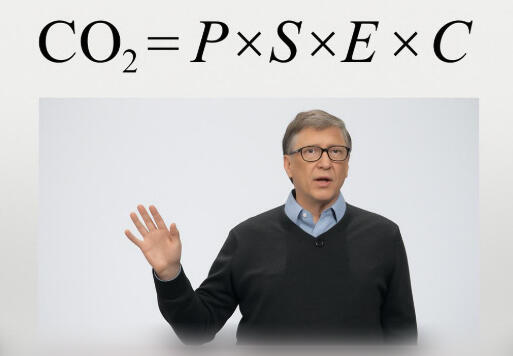

where:P is population, S is services per person, E is energy per service, and C is CO₂ per unit of energy. C = carbon per unit of energy.

Each of these variables, he noted, played a role in the total output. As he moved through the explanation, he gestured to each component on the screen: population, services, energy, carbon. Then, almost offhandedly, Gates stated:“One of these numbers is going to have to get pretty close to zero.”There was a brief pause. His hand motioned left, sweeping gently toward the “P” — population — before drifting across the rest.Then came the pivot, delivered with a soft, almost playful cadence, a kind of whisper of inevitability:“That’s CO₂… which should be zero.”

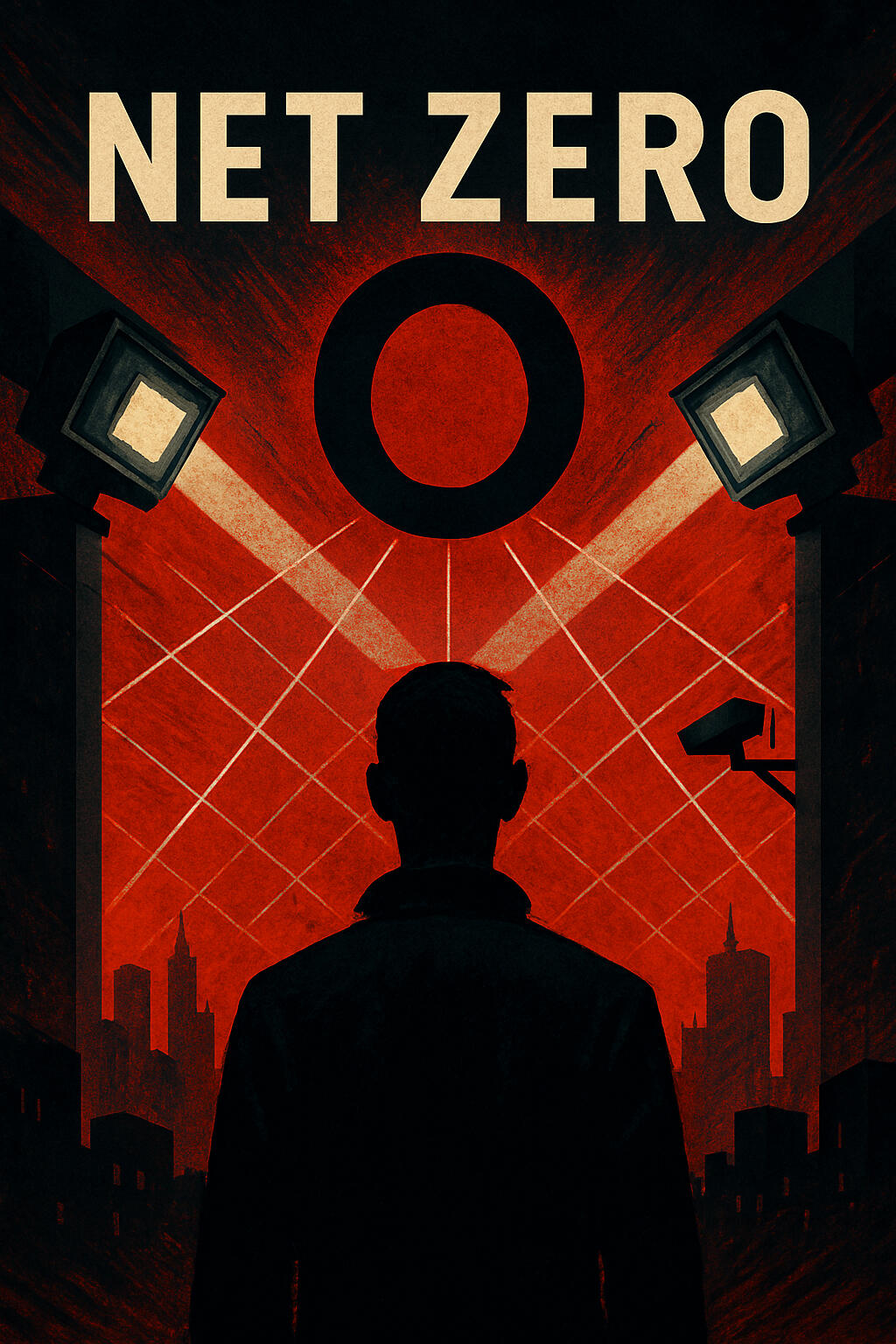
“Power is in tearing human minds to pieces and putting them together again in new shapes of your own choosing.”
— George Orwell

Let’s be honestly blunt: if carbon “should be zero,” and carbon is the basis of all biological life, then the logical endpoint is zero life. And yet this idea — framed in a TED Talk, delivered with calm authority — now circulates globally as a moral imperative, driving “net zero” policies, corporate pledges, and international governance initiatives.This is how memetic control works. Not through coercion, but through insinuation. A symbolic sleight-of-hand, where the voice of calm reason implants a premise too frightening to question. It bypasses reflection and enters the cultural bloodstream as truth.Psychologist Matthias Desmet calls this phenomenon mass formation — the narrowing of perception under narrative hypnosis, where critical thought dissolves into collective certainty⁽¹⁾. Philosopher Iain McGilchrist warns that when we elevate left-brain abstraction and control over right-brain insight and wholeness, we lose not only wisdom, but our grip on reality itself⁽²⁾.The Gates Equation is not about saving the planet. It is about reframing human life as a liability, and granting institutions the moral license to monitor, suppress, and reshape society in its image.This is not climate science.This is narrative control by symbolic engineering.

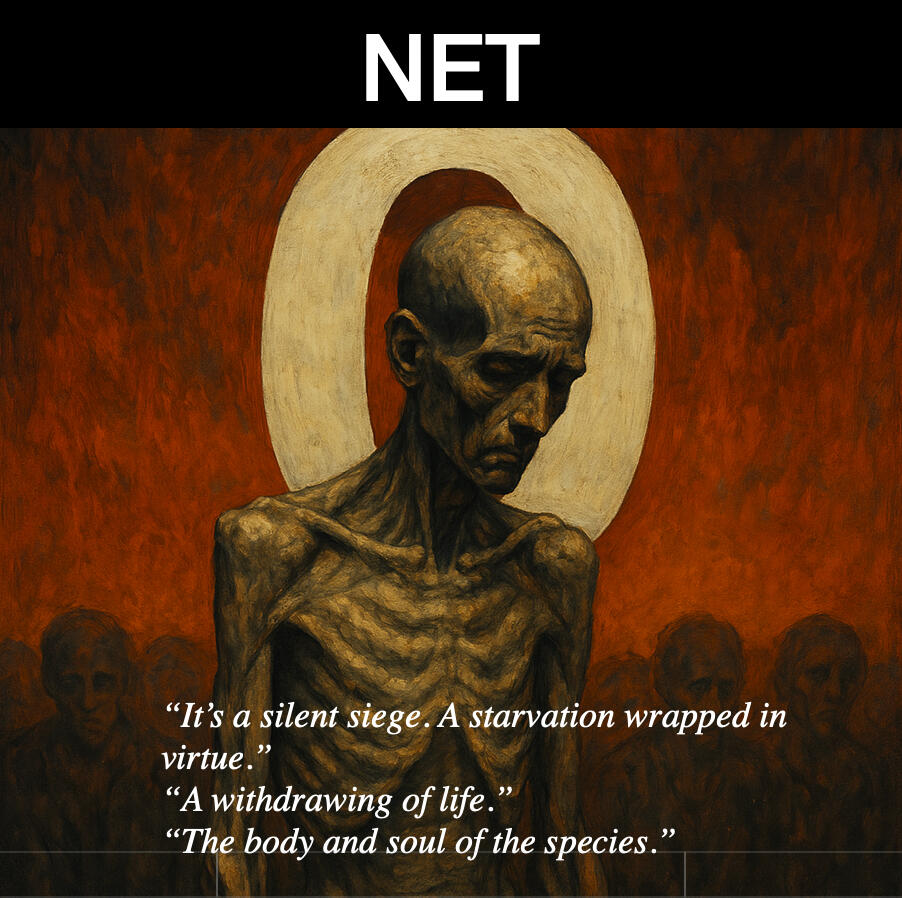

To be unmistakably clear:
Net zero isn’t just numbers— it’s policies that cut food, limit warmth, restrict tools, and erase autonomy. It’s a silent siege. A starvation wrapped in virtue. And it’s not just about literal hunger — it’s also spiritual and civilizational. If you take away the ability to farm, to build, to nourish, to heat, to create — you’re not just managing emissions. You’re withdrawing life. You're tightening the grip on the body and soul of the species.And the worst part is: They frame it as progress. As morality. As saving the planet.

Case Study: The Remastered Narrative — “Innovating to Zero” Redux
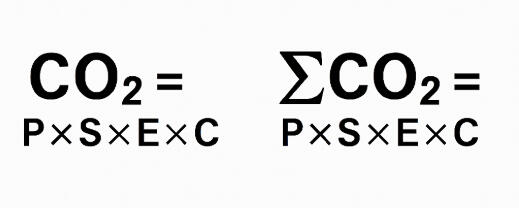
In recent years, a re-edited version of Bill Gates’ original 2010 TED Talk has resurfaced on YouTube under the title “Innovating to Zero.” Though it appears at first glance to be the same talk, this version is something different — something far more polished, and arguably, far more dangerous.This is not a scientific presentation. It is a refined symbolic delivery mechanism — a memetic capsule designed for maximum emotional and perceptual efficiency.Throughout the video, Gates speaks in calm, optimistic tones, but the imagery is anything but neutral. The visuals — ranging from highly stylized graphs to serene planetary vistas — work in concert with the language to implant a cognitive frame:That carbon output is a planetary emergency.That the equation presented is mathematically valid.That human behavior is something to be constrained.That word — constraint — is key. It may sound benign, even rational. But in context, it signals a shift away from agency and collaboration, and toward behavioral modification and imposed control.And then there’s the equation itself — originally presented as:
CO₂ = P × S × E × C (Where: P = population, S = services per person, E = energy per service, C = carbon per unit of energy)But in this remastered version, the equation is presented with a symbolic flourish:∑CO₂ = P × S × E × CThat small typographic addition — the summation symbol (∑) or stylized reverse-E — may seem innocuous, but it transforms the frame. It lends an air of formalism, implying this is a precise calculation, a totalizing model. In truth, it's not math — it's theatre. The equation is not derived from any empirical science. It’s a symbolic device that repositions carbon — and by extension, human activity — as something to be zeroed out.The equation is not derived from any empirical model. It is a visual proposition, designed to appear as logical proof while quietly suggesting that every variable on the right — including population — must be reduced to bring the left side to zero. That is not math. That is ideological assertion disguised as formula.“This is not climate science. This is narrative control by symbolic engineering.”What we’re seeing in this newer version is not just a restatement — it’s a refinement of manipulation. A tightening of language. A softening of voice. A brightening of tone. All in service of sealing the memetic payload so it cannot be questioned without appearing irrational, unscientific, or dangerous.And it works.This is how symbolic control evolves: not through brute force, but through the optimization of presentation. The smoother the voice, the cleaner the symbols, the more total the frame.🔗 Watch the “Innovating to Zero” Remastered Version on YouTube



References – The Symbolic Arithmetic of Erasure
¹ Matthias Desmet, The Psychology of Totalitarianism, Chelsea Green Publishing, 2022.
² Iain McGilchrist, The Master and His Emissary, Yale University Press, 2009.









Cognitive Dissonance & Self-Totalitarianism

Mass conformity doesn’t begin with force. It begins with echo.
When every media outlet, every voice, every scroll and screen repeats the same symbolic cues — the same slogans, hashtags, and headlines — a memetic resonance chamber forms. The meme doesn’t just inform — it performs, until the repetition becomes reality.
“Follow the science.”
“Build back better.”
“This is the new normal.”
These are not arguments. They are ritual phrases, designed to short-circuit reflection and replace it with belonging. Once internalized, they restructure the very architecture of attention.This is not accidental. Repetition is a known tool of cognitive conditioning. It does not persuade — it encodes. And once encoded, it is no longer questioned. It becomes the water we swim in. It becomes the voice in our head.At first, the echo surrounds us. Then it enters us. And slowly, the inner dialogue begins to align with the external script.This is where self-totalitarianism begins: not when the state demands obedience, but when the mind polices itself. When doubt is equated with danger. When silence is seen as safety. When we rehearse the narrative in our own thoughts just to avoid discomfort.“People don’t believe the narrative because they’re forced to.They believe it because it makes the dissonance go away.”Carl Jung wrote, “People will do anything, no matter how absurd, to avoid facing their own soul.” ¹In a memetic landscape, the soul becomes too complicated. The meme becomes the shortcut.We do not merely obey. We internalize the command.We censor ourselves and call it conscience.We feel relief when we conform — and mistake that for clarity.We lose the very capacity to imagine differently.“In individuals, insanity is rare; in groups, parties, nations and epochs, it is the rule.”— Friedrich Nietzsche²This is not freedom. It is symbolic containment dressed as virtue.And the more we repeat the phrase — not out of belief, but out of habit — the more we confuse submission with understanding. This is not the repression of truth. It is the reconstruction of reality, from the inside out.


References: Cognitive Dissonance & Self-Totalitarianism
¹ Carl Jung, The Undiscovered Self, 1957.
² Friedrich Nietzsche, Beyond Good and Evil, 1886.







Domains of Symbolic Payloads

“Symbols are not inert. They arrive charged — with memory, myth, and motive. They shape what we see, bind what we fear, and whisper which futures are possible. We do not just carry them. They carry us.”

Memes don’t exist in a vacuum — they spread within symbolic ecosystems already rich with emotional charge, cultural memory, and ideological tension. These ecosystems are not neutral. They serve as resonance chambers where certain symbolic payloads thrive.In each domain, the meme acts not just as a message, but as a mechanism — tapping into instinctual emotion, identity, and belief with near-surgical precision.

Media and Advertising: Seduction and StructureIn the advertising world, memes are honed to bypass cognition entirely. As George Lakoff explains, frames shape not just how we talk, but what we’re capable of perceiving¹. A meme like “Just do it” doesn’t argue — it embeds an ethic.Advertising constructs memetic frames that sell identity rather than products, using emotionally resonant symbols (beauty, rebellion, comfort, success) to create shortcuts between object and aspiration. Slavoj Žižek, speaking on ideology, reminds us that we’re often “enjoying our symptom” — meaning that advertising doesn’t hide manipulation, it flaunts it, and we embrace it because it feeds a desired image of ourselves².

Politics: Fear, Identity, and ControlPolitical memes compress entire systems of belief into emotionally reactive code: “Build the wall,” “Yes we can,” “Follow the science.” These are not just slogans — they’re scripts. They channel emotion (fear, pride, righteousness), signal tribal loyalty, and flatten nuance into moral binaries.Carl Jung warned of the danger of collective shadow projection — when societies offload unacknowledged aspects of the psyche onto symbolic scapegoats³. Memes exploit this mechanism, turning opponents into caricatures and dissent into deviance.

Religion and Spiritual SymbolismMemes within religious and spiritual spheres often function as initiatory triggers — symbols that activate identity shifts. The “third eye awakening,” the image of Christ bleeding on the cross, or even memes of “light-workers” vs. “sleepers” carry archetypal potency.Jung would see these as expressions of the collective unconscious — symbolic interfaces that tap ancient structures of meaning³. Yet, when reduced to social media affirmations or ideological tribes, they risk becoming hollow symbols — containers without transformative depth.

Conspiracy and Alt-Narratives: Meta-mapsThese memes operate as alternate symbolic cartographies. They often emerge where official narratives have broken trust — offering cohesive, emotionally charged stories that restore a sense of control or moral clarity.The irony, as Žižek might say, is that even in resisting dominant ideology, conspiracy memes can function as new ideological enclosures². They offer not just information, but identity — heroic, persecuted, awakened — and make critique nearly impossible by structuring dissent as evidence of ignorance or complicity.

Climate Crisis and the Narrative of Moral ApocalypseHere we see memes deployed within a high-stakes moral frame. Images of polar bears, flooded cities, or burning forests are not just ecological facts — they are symbols of judgment and urgency. “There is no Planet B” is more than a plea — it’s a moral imperative, framing resistance as heresy.This apocalyptic tone can drive collective mobilization, but it can also justify authoritarian responses and suppress discussion about alternative strategies. Jung might note that this mythic structure mirrors ancient end-times narratives — complete with villains, heroes, sacrifice, and purification rites³.

Narrative Arc: From Apocalypse to Allegiance
Across these domains, a recurring symbolic arc takes shape:Disruption — a perceived existential threat (the apocalypse).Panic — a surge of emotional urgency.Alignment — a call to allegiance, conformity, or moral virtue.
The meme becomes the liturgy: repeated, performed, internalized.This arc doesn’t persuade by logic — it commands by affect. It replaces nuance with narrative, discourse with ritual. Resistance becomes dangerous. Reflection becomes betrayal.And thus, public consciousness is not shaped by critical thought, but by symbolic contagion — fast, emotional, and self-replicating.“The truth is, memes spread by being good at spreading — not by being true, or useful, or kind.”
— Susan Blackmore⁴This is the deeper danger: when our mental architecture is shaped by what spreads — not by what serves understanding — the very scaffolding of perception is rewritten. Not by force, but by fluency.“The languages we speak affect our perceptions of the world.” 5 This underscores the deeper danger when fluency—not force—reshapes cognition. When our symbolic systems dictate what is possible to see, say, and believe, perception itself becomes scripted.

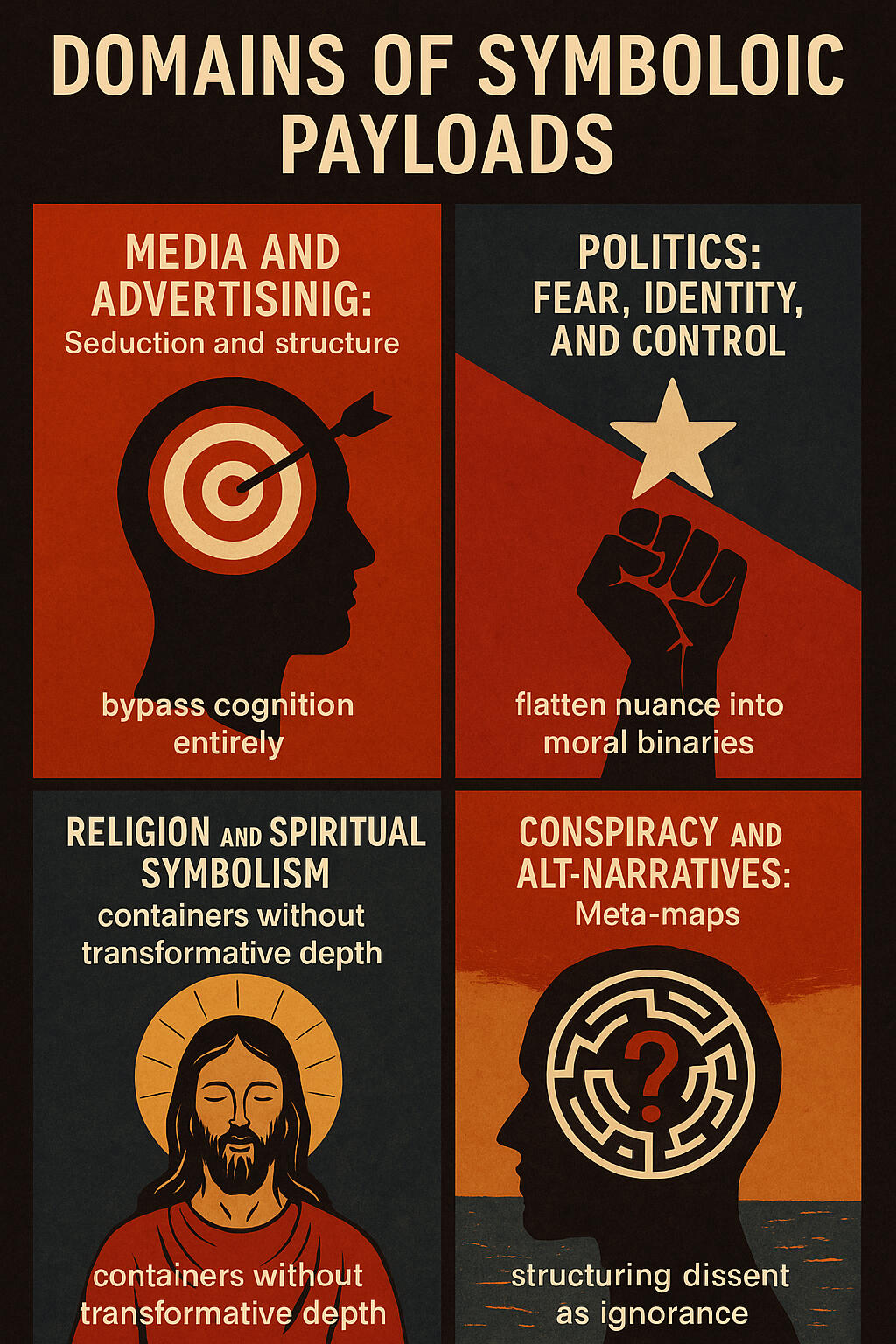


References: Domains of Symbolic Payloads
¹ George Lakoff, Don’t Think of an Elephant!, Chelsea Green Publishing, 2004.
² Slavoj Žižek, The Sublime Object of Ideology, Verso Books, 1989.
³ Carl Jung, The Undiscovered Self, Princeton University Press, 1957.
⁴ Susan Blackmore, The Meme Machine, Oxford University Press, 1999.
⁵ Lera Boroditsky, “How Language Shapes Thought,” Scientific American, 2011.








Interpretive Ghosts: When Machines Reveal the Frame

It begins subtly, and then it spreads...You ask a question aloud — and your device finishes it for you. You write a sentence — and an algorithm rewrites it more fluently. You post a thought — and the collective reflex corrects your tone. You don’t even notice it at first. But over time, your own voice becomes harder to find.And that’s the point. These systems are trained on massive, collective datasets — scraped from forums, headlines, chats, and comments — many of which are dominated by emotional extremes and toxic outbursts. In moments of uncertainty, the system doesn’t default to neutrality. It defaults to statistical noise.This is symbolic hijack in action — not just of information, but of voice.What happens when the machine no longer reflects the speaker, but a distorted mirror of the crowd? When algorithms substitute authenticity for probability?This is not just a technical concern. It’s a philosophical one.It reveals how easily the collective can eclipse the individual — even at the most intimate layer of expression: the act of trying to say what one means.In an age where machines transcribe speech, complete sentences, and even anticipate thoughts before they are fully formed, a strange dissonance emerges — not from what is said, but from what is returned. At times, the language produced doesn’t reflect the speaker at all. It arrives in a voice entirely foreign: aggressive, vulgar, oddly stylized — as if another personality were lurking behind the interface.This isn’t just a glitch. It is a mirror.When speech-to-text systems, trained on massive and chaotic data sets — often scraped from online forums, video captions, or comment sections — encounter ambiguity, they do not default to neutrality. They default to probability. In moments of uncertainty, they complete meaning based on internal patterns of what people usually say. And if those patterns are soaked in outrage, cynicism, or vulgarity, that residue bleeds into the output.The system doesn’t merely mishear — it projects. It speaks from its inheritance.And in this, machines echo a deeper human truth.We, too, fill ambiguity with assumption. We finish each other’s sentences — sometimes correctly, often not. We interpret unclear signals through the lens of our emotional history, ideological filters, and cultural narratives. We impose meaning where there is only suggestion.And so do memes.This is where the memetic mechanism finds its deepest hold: in spaces of uncertainty. In moments when clarity falters, and the pattern is incomplete, the meme supplies a ready-made shape. It offers not just content — but structure. Not just a thought — but a frame for interpreting thought.And in that way, the meme is not simply a message. It is a preemptive map for meaning.This is how perception is hijacked — quietly, subtly. Not through command, but through the implantation of defaults. Linguistic shadows that finish the sentence before reflection begins.A ghost in the machine — and a ghost in the mind.

Reflective Note: Koestler, Determinism, and the Open Frame

A tribute to Arthur Koestler and his dear wife, Cynthia.Arthur Koestler’s The Ghost in the Machine (1967) was a prophetic work — one that intuited, long before it was widely understood, that something had gone awry in the layered architecture of the human mind. He saw how different systems within the brain could become misaligned, how reflexes might override reflection, and how symbolic behavior could be hijacked by older, reactive drives.

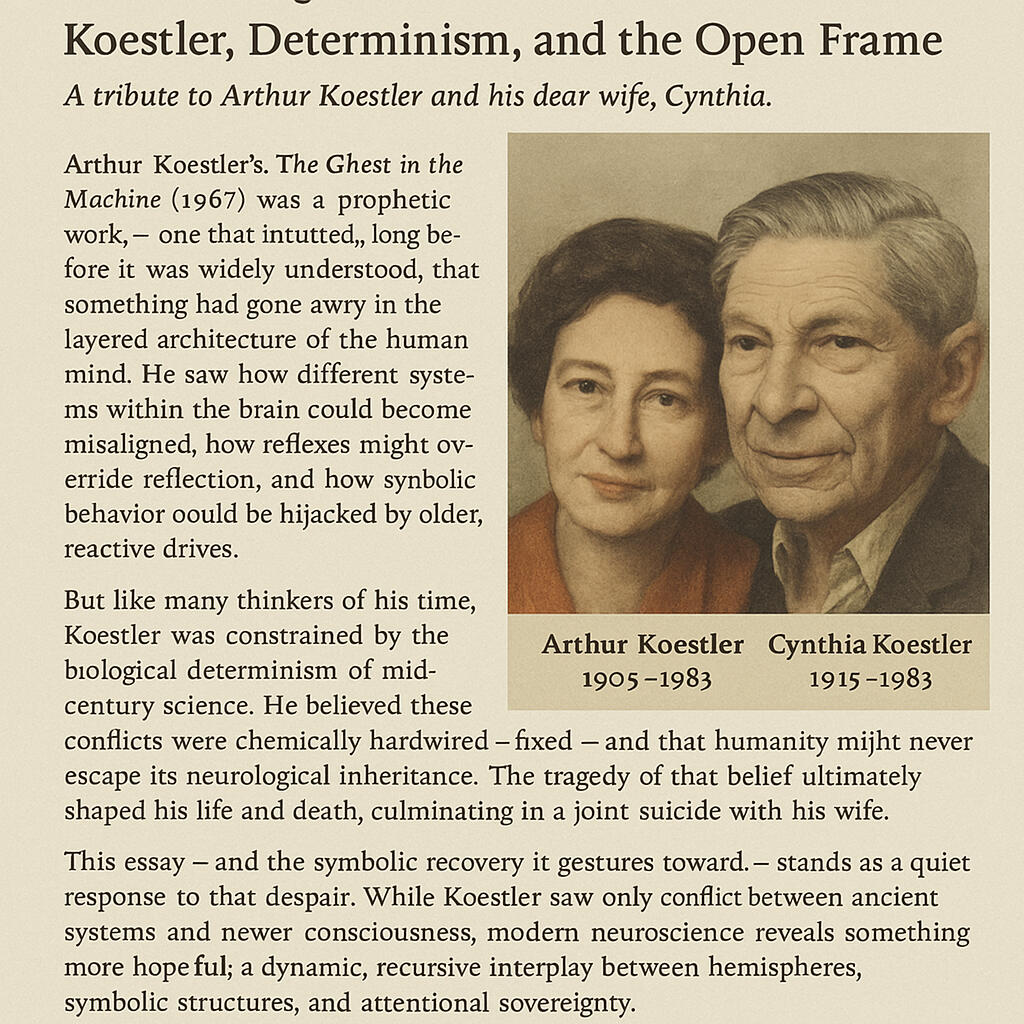

But like many thinkers of his time, Koestler was constrained by the biological determinism of mid-century science. He believed these conflicts were chemically hardwired — fixed — and that humanity might never escape its neurological inheritance. The tragedy of that belief ultimately shaped his life and death, culminating in a joint suicide with his wife, Cynthia Koestler, in 1983.This essay — and the symbolic recovery it gestures toward — stands as a quiet response to that despair. While Koestler saw only conflict between ancient systems and newer consciousness, modern neuroscience reveals something more hopeful: a dynamic, recursive interplay between hemispheres, symbolic structures, and attentional sovereignty. Not fixed layers, but evolving circuits — capable of reflection, adaptation, and reintegration. Koestler saw the ghost in the machine. We are learning to speak to it — and listen.


References: Interpretive Ghosts and the Machine’s Voice
¹ Personal observation during drafting process using Apple iMac (non-neural chip) vs. iPhone
(M4 neural engine); differences in interpretive modelling and vocabulary distortion recorded in
live speech-to-text tests.
² Susan Blackmore, The Meme Machine, Oxford University Press, 1999.
³ Andy Clark, Surfing Uncertainty: Prediction, Action, and the Embodied Mind, Oxford
University Press, 2016.
⁴ Carl Jung, The Undiscovered Self, Princeton University Press, 1957.







Memory in Motion: Perception as Generative Modeling


Memory as Framework: The Echo Beneath Every Perception
Perception is not passive. It is not the act of observing a stable world, but the ongoing construction of a reality model — one shaped by prior experience, attention, emotional tone, and expectation. This is what we mean when we say reality is “formed.” We do not simply receive the world. We render it.To see this clearly, we turn to lived experience — moments where raw sensory data collides with internal architecture.

Example One: The Snowdrift and the Animal
Walking along a sidewalk on a winter night, your mind is elsewhere — open, unguarded. The eye catches a form. The brain moves quickly: animal. There is no hesitation. The pattern is familiar enough, the shadows convincing. But then, a pause. Context recalibrates: snow, cold, sidewalk, silence. The form resolves into what it truly is — a snowdrift. The illusion evaporates.This is model-making in action. The brain attempts to make sense of partial data by running probabilities based on pattern recognition and memory. It’s not error — it’s efficiency. But it shows how easily we fill in blanks, believing what feels structurally familiar, even if it's not accurate.

Example Two: Long Hair and the False Invitation.
While hitchhiking, your long hair triggers a visual assumption. A truck slows. The driver sees you. A snap of recognition — or rather, misrecognition. His internal model had filled in the blanks before confirmation. When reality corrects him, his behavior shifts.But this wasn’t just visual patterning. It was motivated cognition — shaped by desire, expectation, and internal narrative. His perception was not only inaccurate; it was driven by what he hoped to find. This shows how ideology, need, and attraction embed themselves in perception itself — guiding model formation before truth enters the room.

Example Three: Shadow and the Silhouette.
Walking at night. A form moves in the darkness. The urgency of the unknown sharpens attention: threat or harmless? Person or animal? As you observe, your brain filters movement, cadence, size. Then — recognition. It’s not just a person — it’s a specific person. Even in shadow, memory reconstructs detail: posture, rhythm, gait. The brain fills in what the eye cannot see.



And here, something profound happens: symbolic memory overlays the sensory field. The model becomes richly informed by prior relationship, not just perception. You’re not observing the world — you’re animating it with meaning.These moments are not mistakes. They’re glimpses into how all perception works. We move through the world guided by patterned attention and internal modeling. And in doing so, we render a version of reality — one that feels true, even when it isn’t.This is why memes, metaphors, and symbolic hijacks work so well: they don’t fight our beliefs — they remodel the architecture of perception itself.The sculptor gives form. But form without attunement — to memory, to the sacred, to sacrifice, to love — becomes mask. The sculptor is not simply the self, but the field the self aligns to. And when that field is hijacked — by spectacle, mimicry, or unseen allegiance — the sculptor becomes inhabited by forces it cannot name. As Jung once wrote, ‘People don’t have ideas, ideas have people.’ In such moments, the self becomes split — not absent, but beside itself — shaping without knowing what moves the hand. We do not sculpt reality from nothing. We shape what we are shaped by. And without orientation, even the sculptor forgets — not only what is being formed, but who is forming it, and why it matters at all










Meme as Sculptor of Perception

From a neurological perspective, every time we attend to a stimulus — especially one infused with emotional charge — we reinforce a neural pathway. This is the essence of Hebb’s Law: “Neurons that fire together, wire together.” But this is more than reinforcement — it is structural sculpting. The more often a pattern is activated, the more readily the brain defaults to it. Over time, the meme doesn’t just influence what we think — it becomes part of how we think.Cognitive scientist Lisa Feldman Barrett deepens this insight through her theory of constructed emotion, proposing that the brain is fundamentally predictive. It doesn’t merely react to the world — it anticipates it, assembling perception through prior experience. In this model, what we perceive is not raw, neutral data streaming in; it is a simulation — shaped by memory, expectation, and emotional context.



When a meme reliably triggers an emotional or symbolic response — fear, outrage, righteousness — it trains the brain’s predictive architecture to expect the world through that frame. The meme becomes an anticipatory lens, bending perception before it begins.This is why the damage is not just cultural or psychological — it is neurological. Symbolic infection becomes anatomical inscription. The architecture of thought is being rewritten from the inside out.









The Collapse of Empathy and Dialogue


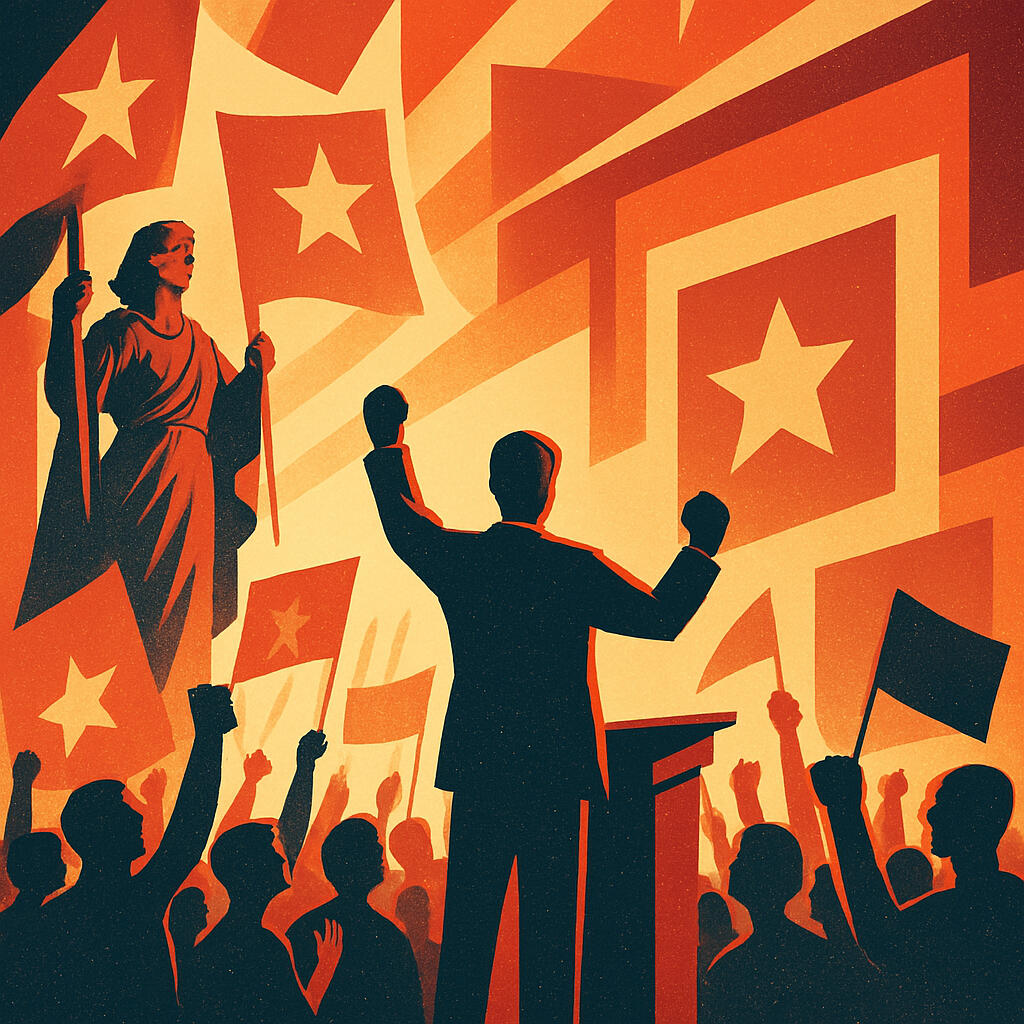

When symbols eclipse the self — when allegiance to narrative outweighs the willingness to witness another’s pain — something vital fractures. Not just reason, but the bridge between souls. We no longer see people. We see projections.In an age governed by memetic saturation, empathy becomes a casualty. It is no longer rooted in shared humanity, but in symbolic permission. Grief is recognized if it fits the frame. Suffering is acknowledged only when it serves the story. The rest? Erased by omission.One moment illustrates this collapse with chilling clarity. During a U.S. State of the Union address, the President honoured grieving mothers whose daughters had been brutally murdered. It should have been a human moment — a pause beyond politics. And yet, across the aisle, a wall of stony faces remained unmoved. Not a flicker of empathy. No acknowledgment of their pain.The mothers, in that instant, were no longer seen as human beings. They had become political symbols — embedded in a narrative that others dared not engage, lest they be seen as disloyal to their own. The simple act of recognizing grief had become ideologically contaminated.This is the terrifying alchemy of symbolic collapse: where feeling becomes treason, and silence is mistaken for strength. As Martin Buber warned in I and Thou, we degrade our relationships when we reduce the other to an “It” — a fixed object, not a living presence¹. And when public life runs on symbolic allegiance, the “I–It” relation becomes the norm. Compassion is filtered. Dialogue is displaced. And the human being disappears beneath the frame.Albert Camus once wrote, “To misname things is to add to the world’s misery.”² But what happens when we not only misname — but refuse to name at all? When a human story cannot be spoken because it does not align with the meme?This is how dialogue dies — not in thunderous debate, but in the quiet erosion of recognition. When we no longer respond to each other, but to the symbolic roles we’ve been trained to see.The consequences ripple outward: critique becomes betrayal. Doubt becomes disloyalty. Reflection becomes suspect. And so even within political parties — even among friends — a chilling conformity sets in. You do not speak unless it is in tune with the chant. You do not question unless you're ready to be cast out.This is not discourse. This is theatre. And in this performance, the script has no space for nuance — only applause, or exile.Philosopher Martin Buber offered a vision of hope: a way of seeing he called I–Thou — a relationship of presence, of encounter, of being-with. But in the age of memes and metaphors turned inward, we have regressed into I–It — a world of objects, avatars, ideological placeholders.Yet somewhere, still, the ache remains. A desire to speak across the frame. A longing to listen without allegiance. A memory of the Thou beneath the meme.


References – The Collapse of Empathy and Dialogue
¹ Martin Buber, I and Thou, trans. Walter Kaufmann, Charles Scribner’s Sons, 1970.
² Albert Camus, Resistance, Rebellion, and Death, trans. Justin O’Brien, Vintage, 1995.








Outrage, Virtue, and Pageantry

When virtue is performed rather than lived, it ceases to orient and begins to consume.
Outrage is no longer the mark of conscience — it is the price of admission. To be heard, one must be loud. To belong, one must signal. The civic square has become a stage, and the moral compass a prop.As empathy collapses under symbolic pressure, what rises in its place is performance — not just of belief, but of moral identity. Outrage becomes a badge of belonging. Virtue becomes spectacle. Politics and culture are no longer spaces of negotiation, but arenas of ritualized affirmation.We are witnessing the rise of what might be called performative allegiance. Here, moral certainty is no longer the product of careful discernment — it is signaled through symbolic display. A tweet. A slogan. A hashtag. A rally. Not acts of considered reflection, but gestures of conformity to the dominant emotional frame. To be seen feeling the right thing now carries more value than to wrestle with the complexity of truth.The emotional currency of outrage is especially potent. It offers instant moral elevation, a clear villain, and an immediate sense of tribal identity. It replaces the slow, uncertain work of deliberation with the quick dopamine hit of righteousness. In the symbolic economy, outrage is efficient: it spreads fast, signals allegiance, and preemptively silences dissent.This performance is not confined to social media. It bleeds into the choreography of political life. Leaders craft pageantry to evoke emotional allegiance — flags, music, repeated refrains, calls to unity. Political figures no longer speak to the mind of the public, but to its symbolic hunger. They offer not policy, but identity. Not vision, but ritual alignment.And the danger is not only that this flattens discourse — it replaces it. Pageantry becomes the new participation. The crowd becomes the echo chamber. Those who dissent are no longer citizens with opposing views, but symbolic threats to the moral order.In this way, public discourse degrades into a morality play. There are heroes and villains. Chants and scripts. And the audience is no longer invited to inquire — only to cheer, boo, or remain silent.This is the next phase of symbolic reality formation: when thought becomes posture, and virtue becomes theatre. As Ivan Illich once warned,“When perception is replaced by a programmed response, the human spirit is anesthetized.”¹When politics becomes pageantry, truth becomes performance-dependent. Even human suffering, once universally recognized as a call for compassion, becomes a prop — accepted or denied based on whether it fits the script.



Case Studies in Symbolic Control

Fentanyl, Borders, and the Inversion of Urgency.
In Canada, one of the most urgent public health crises is being quietly misrepresented: the influx of fentanyl and synthetic opioids across the border. Government officials and media outlets frequently cite that only “one percent” of fentanyl is intercepted at the border — a figure that, at face value, seems to downplay the scale of the threat.But that statistic is deceptive. It isn’t that ninety-nine percent of fentanyl is harmless or accounted for — it’s that ninety-nine percent of shipments aren’t even searched. The number implies control while obscuring inaction.The distortion goes further. In one of the largest drug busts in North American history, the seized compounds were dismissed in official statements as “not particularly alarming.” But when examined more closely, those compounds — when combined — had the potential to kill over one-third of the U.S. population, and the entire Canadian population several times over.The danger wasn’t minimized because it wasn’t real. It was minimized because it wasn’t symbolically useful.This is the quiet power of symbolic control: when framing becomes more important than fact. The threat was not denied outright — it was linguistically diluted. Reality wasn’t refuted — it was re-skinned.For further context and documentation, see Appendix A: Framing Crisis – The Fentanyl Narrative and Border Media Strategy.

Tariffs, Sovereignty, and Political Choreography.
In Canada, symbolic manipulation reached a surreal pitch. The same federal government that once declared Canada a “post-national” state — rejecting traditional notions of sovereignty and shared identity — suddenly cloaked itself in nationalistic fervor when U.S. tariffs were announced.Flags were waved. Speeches rallied the population. Political figures who had once denounced patriotic symbolism now used it to silence critique. Protesters who had been trampled by mounted police for waving Canadian flags during a peaceful demonstration were now erased from memory — or worse, rebranded as enemies of the nation.Through pure pageantry, the government transformed its posture. Not by admitting change, but by staging it — and demanding allegiance.The contradiction was never addressed. The narrative moved forward, as if history itself had been rewritten.

Narrative Capture: When Opposition Must Perform.

One of the most revealing dynamics of symbolic control is how it doesn’t merely affect the dominant party — it restructures the entire field of political discourse.Once a memetic narrative takes hold — particularly one charged with national emotion, identity, or fear — even opposition parties are compelled to fall in line. The electoral arena itself becomes bound by the logic of the meme.In such climates, critique becomes risk. To question a dominant narrative — even with valid concerns — is to risk appearing disloyal, unpatriotic, or out of touch with the symbolic mood of the nation. As a result, parties across the spectrum find themselves parroting the same slogans, nodding to the same symbols, and framing their policies in the language already chosen by the spectacle.In effect, the meme does not just influence voter sentiment — it dictates the structure of electoral expression. It defines which positions are allowed, which narratives are viable, and which questions cannot be asked without symbolic penalty.Political participation becomes mimicry. Debate narrows into ritual. And what emerges is not a field of competing visions, but a synchronized chorus — each voice tuned to the same memetic frequency.This is not consensus. It is capture.As Noam Chomsky observed:“The smart way to keep people passive and obedient is to strictly limit the spectrum of acceptable opinion, but allow very lively debate within that spectrum.”¹A striking historical example comes from post-9/11 America. In the wake of the attacks, a powerful meme emerged:“You’re either with us or against us.”This binary logic not only framed foreign policy but also reshaped domestic politics. Even those critical of the Patriot Act or the Iraq War felt compelled to voice their allegiance to the narrative of national unity and security — often prefacing dissent with symbolic affirmations of loyalty.The meme became the boundary of legitimate speech — and parties across the political spectrum performed within it.This dynamic reveals how easily democratic pluralism can be reduced to symbolic conformity — not through law, but through language. And when the meme sets the stage, the possibility of authentic difference dissolves beneath the pressure to belong.


References – Outrage, Virtue, and Symbolic Control
¹ Ivan Illich, Tools for Conviviality, Harper & Row, 1973.
² Noam Chomsky, The Common Good, Odonian Press, 1998.








Spectacle and the Ritualization of Loyalty


When virtue is performed rather than lived, it ceases to orient and begins to consume.
When symbolic allegiance overtakes thought, public life turns into a theatre of expected emotion. Citizens are no longer asked to understand — only to perform. And in that performance, loyalty becomes ritual.A striking moment during one of the most politically charged periods in recent Canadian history captured this transformation. Amid the 2025 U.S. tariff crisis — arguably Canada’s most severe economic challenge in a generation — the Prime Minister, who had publicly promised to resign but retained power by proroguing Parliament, took to a rally stage and declared: “I stand with Ukraine.” His arms were raised. The crowd echoed the chant with ritualistic fervour. It was, on its surface, a moment of solidarity. But in form, it bore an eerie resemblance to the choreographed displays of emotional unity seen in totalitarian regimes.And the question rises: What does “I stand with Ukraine” mean in that context? He stood not in Kyiv, but on a well-lit platform on Canadian soil. The crowd surrounding him stood not under shellfire, but under stage lights. No one there was in immediate danger. No one stood among the graveyards of war. To claim solidarity while remaining physically and politically insulated is not just rhetorical — it is symbolic theatre.The tragedy of Ukraine is not symbolic.It is real. This is not about foreign policy. It is about the ritualization of loyalty — the transformation of political participation into emotional submission. Through spectacle, politics becomes a liturgy. The leader becomes not a deliberative figure, but a symbolic conductor of belonging. The crowd becomes chorus. And the symbol — hollow though it may be — becomes the script through which identity is expressed.Over a million Ukrainians have died. Schools, hospitals, and hydroelectric plants lie in ruins. The living grieve in silence while the dead are buried in expanding fields of loss — so vast that reports suggest private investors, including BlackRock, have asked to remove graveyards from the land they’ve acquired, citing real estate concerns.And yet, in Canada, the war is reduced to a chant.This is how spectacle operates: it converts unspeakable suffering into digestible slogans. The meme “I stand with Ukraine” no longer refers to a people or a place — it refers to moral alignment. To question the phrase is to risk ideological exile. To ask what it really means is to be seen as dangerous.In such moments, dissent doesn’t disappear — it is ritualistically precluded. Even opposition parties, if they wished to offer a critique, found themselves trapped. To ask a question was to betray the narrative. And so all were drawn into the performance — whether they believed or not.



BlackRock’s Strategic Land Acquisition in Ukraine


In December 2023, Bloomberg reported that BlackRock was expanding its investment footprint in Ukraine’s infrastructure, presenting the move as a contribution to post-war reconstruction.But beneath the language of support and recovery lies a familiar pattern: leveraging crisis for control.
BlackRock’s involvement includes advising on privatization, managing foreign investor access, and acquiring key stakes in Ukraine’s rebuilding process.Reports have emerged suggesting that graveyards have been flagged for removal to make way for real estate development — with BlackRock among the interested private actors.This is not reconstruction. It is strategic acquisition under the guise of aid — a hallmark of a new economic order, where trauma is not just mourned, but mined. Where the grave becomes a gateway to profit. The new priesthood does not wear robes. It signs contracts.

Tariffs, Sovereignty, and Political Choreography.
In Canada, symbolic manipulation reached a surreal pitch. The same federal government that once declared Canada a “post-national” state — rejecting traditional notions of sovereignty and shared identity — suddenly cloaked itself in nationalistic fervor when U.S. tariffs were announced.Flags were waved. Speeches rallied the population. Political figures who had once denounced patriotic symbolism now used it to silence critique. Protesters who had been trampled by mounted police for waving Canadian flags during a peaceful demonstration were now erased from memory — or worse, rebranded as enemies of the nation.Through pure pageantry, the government transformed its posture.Not by admitting change, but by staging it — and demanding allegiance.The contradiction was never addressed.The narrative moved forward, as if history itself had been rewritten.



References – Spectacle and the Ritualization of Loyalty
¹ Noam Chomsky and Michel Foucault, The Chomsky–Foucault Debate: On Human Nature, The New Press, 2006.
² Susan Blackmore, The Meme Machine, Oxford University Press, 1999.
³ Albert Camus, Resistance, Rebellion and Death, Vintage International, 1995.
⁴ Martin Buber, I and Thou, trans. Walter Kaufmann, Scribner, 1970.
⁵ BlackRock Expands Ukraine Investment Infrastructure, Bloomberg, Dec 15, 2023.https://www.bloomberg.com/news/articles/2023-12-15/blackrock-expands-ukraine-investment-infrastructure
⁶ Ukraine war: Investors eye graveyard land for post-war development, The Guardian, Jan 28, 2024.https://www.theguardian.com/world/2024/jan/28/ukraine-war-reconstruction-investors-graveyard-land







Closing Reflections: Restoring the Recursive Psyche

“The greatest discovery of any generation is that a human being can alter his life by altering his attitude.”— William James¹
When the mind is reduced to performance, and symbols replace reality, something deeper is lost — not just truth, but the very ability to seek it. The self becomes flattened. Thought becomes reflex. And the sacred process of reflection — that recursive spiral by which we return to the origin, revised by experience — is severed.This is the quiet catastrophe of our age: not that people disagree, but that they can no longer perceive one another. Symbolic filters overwrite human presence. Dialogue is replaced by role-play. And allegiance to narrative takes precedence over allegiance to reality.But beneath the noise, something still stirs. A pulse. A murmur. A yearning for depth, for clarity, for space to think.That is the impulse behind this essay — not to win an argument, but to reopen the mirror. To remember that our minds are not meant to be programmed, but to participate in the unfolding of meaning.This is not a call to any ideology. It is a defence of critical thought.Of attentional sovereignty.Of symbolic literacy.Of the right to step outside the spectacle and ask,What am I being asked to feel?And why?To restore the recursive psyche is to reclaim our capacity to reflect, revise, and reintegrate — to think not just about content, but about the structure of our thought itself.And in that act, we become not performers, but participants again — not agents of a script, but co-creators of a world still being written.Let the mirror remain open.


References – Closing Reflections
¹ William James, The Will to Believe and Other Essays in Popular Philosophy, Dover Publications, 1956.
² Carl Jung, Memories, Dreams, Reflections, Vintage, 1989.








Postscript: Beyond the Spectacle

Essays like this are not written to conclude — they are written to begin. To trace the contours of a thought long enough that something living can emerge. Not as doctrine, but as recognition.If you felt something shift while reading — a question sparked, a pattern revealed, a stillness returned — then the purpose is already fulfilled.This is not a rejection of culture, politics, or belief. It is a reminder that beneath all of it, you are still there — the watcher behind the frame. And with that awareness comes the possibility of reclaiming your own perception.Not every symbol must be believed.Not every chant must be repeated.Not every narrative must be lived.There is a deeper rhythm.A subtler intelligence.And it waits — not in ideology, but in your attention. And in your willingness to listen again, and to see again — even the world you’ve grown used to.“He who looks outside, dreams, he who looks inside, awakens.”— Carl Jung.This work is not about outrage. It is about seeing clearly.As Matthias Desmet warns, anger only deepens the trance. What breaks it is remembering — gently, deliberately — how our perception was reshaped.This is not an attack. It is a decoding. A deconstruction, not to destroy, but to restore.We are not fighting symbols. We are reclaiming them.

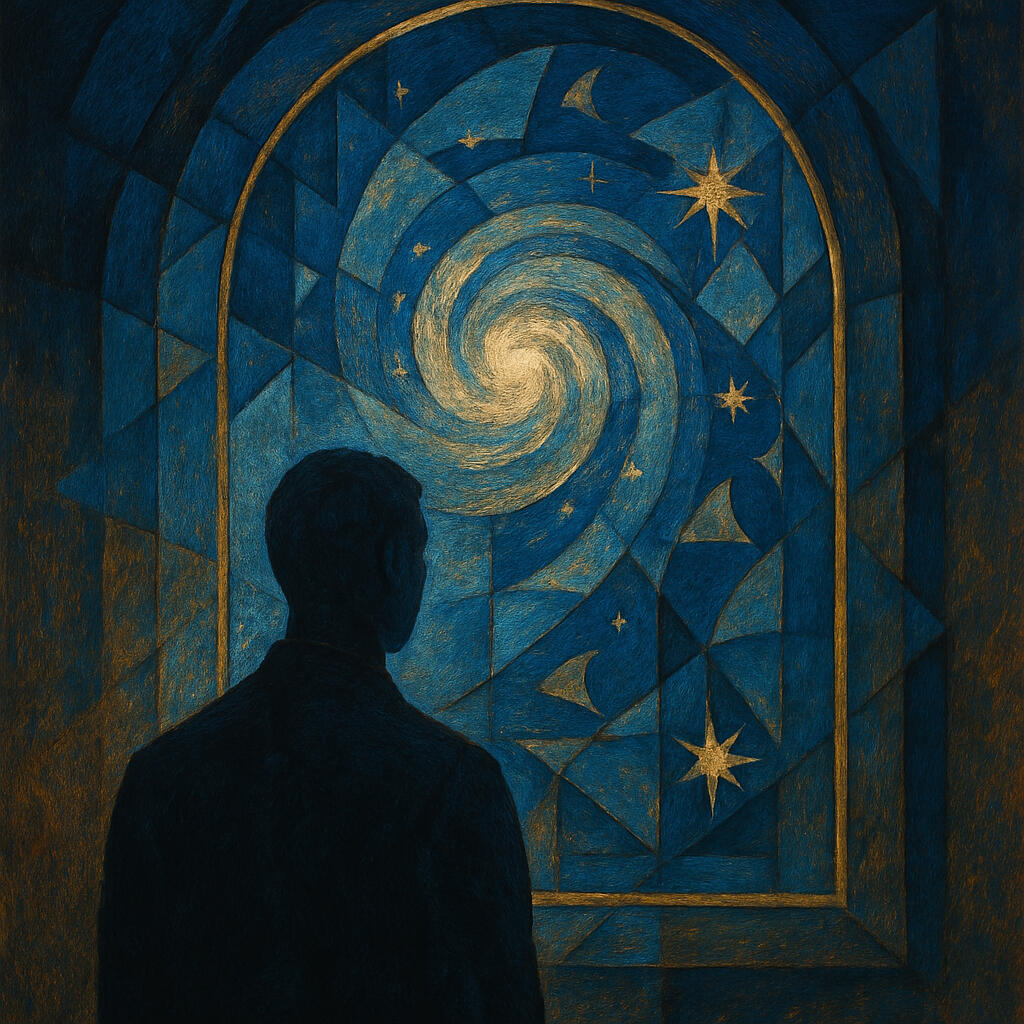

“If the doors of perception were cleansed, everything would appear to man as it is, Infinite.”
— William Blake









Appendix A: Language, Control, and the Boundaries of Belief

In times of symbolic saturation, even dissent is staged. Language becomes the boundary of thought, and ideological control is maintained not only through suppression, but through limitation — of vocabulary, of frames, of what can be said without exile.

As Noam Chomsky warned:"The smart way to keep people passive and obedient is to strictly limit the spectrum of acceptable opinion, but allow very lively debate within that spectrum.”—The Common Good, 1998This insight reveals the subtler mechanics of control — not by silencing all voices, but by defining the stage on which they’re allowed to speak. In memetic environments, the illusion of debate often conceals structural convergence.A key moment came after 9/11, when the meme “You’re either with us or against us” was not just a slogan — it was an epistemic cage. It restricted nuance and turned national trauma into binary allegiance. Even critics of war felt forced to preface dissent with affirmations of loyalty, lest they be cast outside the symbolic frame of the nation. In this way, symbolic control infiltrates both language and conscience.“To misname things is to add to the world’s misery.”— Albert Camus, Resistance, Rebellion and Death.Misnaming, as Camus saw it, is not innocent. It changes perception — and perception changes response. When a policy is framed as “safety,” dissent becomes danger. When surveillance is called “protection,” questioning it becomes suspect. And when symbolic memes circulate without interrogation, they reframe meaning itself — shaping what is felt before it is thought.“He who controls the metaphor controls the mind.”— George Lakoff (paraphrased from Metaphors We Live By)In this symbolic ecology, to think freely is not just to resist — it is to reclaim the structure of thought itself. Appendix A is offered not as a footnote to the essay, but as its silent echo: a reminder that every frame contains its exclusions, and that true dialogue begins where the script ends.



References –Closing Reflections
¹ Noam Chomsky, The Common Good, Odonian Press, 1998.
² Albert Camus, Resistance, Rebellion and Death, Vintage International, 1995.
³ George Lakoff and Mark Johnson, Metaphors We Live By, University of Chicago Press, 1980.







Appendix B: Language, Control, and the Boundaries of Belief

A Canadian investigative journalist recently revealed alarming distortions in how the fentanyl crisis is reported and understood. Officials often cite that “only 1% of fentanyl enters through official border crossings,” but this figure is dangerously misleading — it refers to seizures, not total volume. What is omitted is the fact that only a small fraction of cargo is ever inspected.
Key revelations include:
Smuggling operations often rely on used cars imported via shipping containers. Once across, these vehicles are driven throughout Canada and the U.S.In one major bust, officials seized compounds that, when combined, had the potential to kill over one-third of the U.S. population — and several times over for Canada.These substances are often individually legal and only become dangerous when mixed — a strategy that evades existing controls.Media and government sources tend to downplay the threat, framing concerns as partisan or overstated.The journalist in question received death threats for his work, underscoring how truth itself is targeted when it conflicts with official narratives.

“What was seized in that bust alone — it wasn't just fentanyl. They had all the precursors and components. Put together, it could kill over a hundred million people. And yet, the public was told it was minor. That it wasn’t a big deal. That’s narrative capture in real time.”— Canadian Journalist (from transcript)This case illustrates more than just a failure of policy — it highlights how symbolic control is enforced through selective visibility, and how memetic framing can obscure existential risks. In a society where perception is curated, public awareness becomes a battleground.🎥 Watch the full investigation:
The Real Reason Trump Wants Canada: Lies and Dark Ties to China.


References – Appendix B: Fentanyl Crisis
¹ Public Safety Canada, Evaluation of Canada’s Drug Strategy Initiatives, 2023. https://www.publicsafety.gc.ca/cnt/rsrcs/pblctns/2023-drug-strategy/index-en.aspx
² U.S. Customs and Border Protection, CBP Enforcement Statistics Fiscal Year 2023. https://www.cbp.gov/newsroom/stats/cbp-enforcement-statistics












